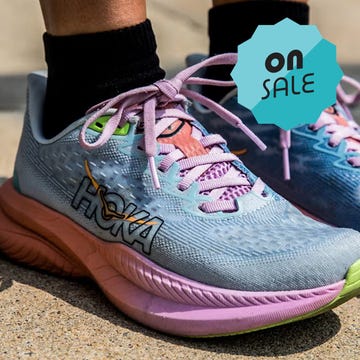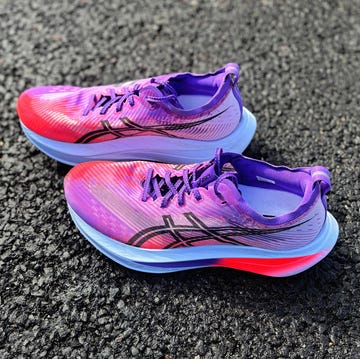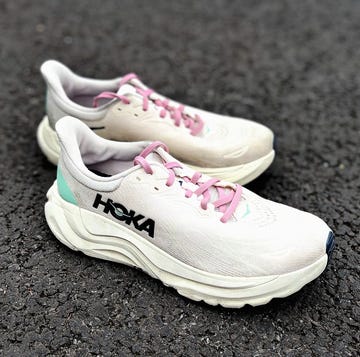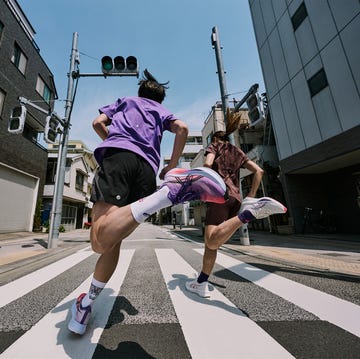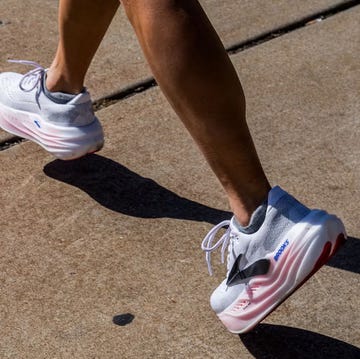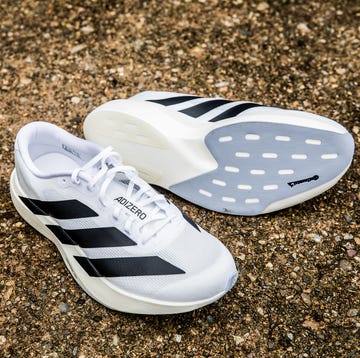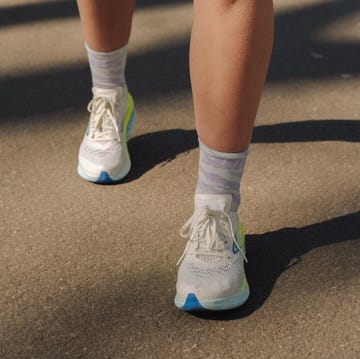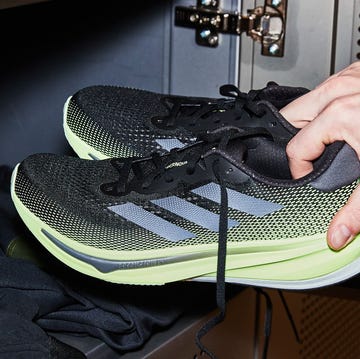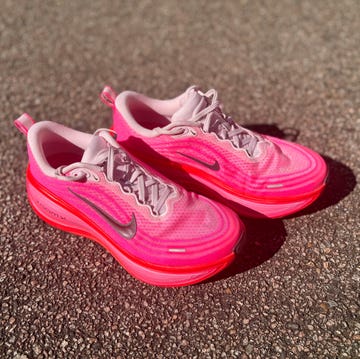Along with companies like Hoka and On, Under Armour is part of a ‘new’ wave of running shoe brands that launched in the past few decades. Founded by University of Maryland football player Kevin Plank in 1996, Under Armour’s technical base layers rapidly gained popularity among athletes, leading to broader appeal for shorts, sweats, and other athletic apparel.
Under Armour released its first running shoes in 2009. After a tough start, it gained traction in the running market in the last 10 years with its SpeedForm running line. Lately, new models like the Velociti Elite 2 prove that the best Under Armour running shoes can keep pace with the big players in running.
The Expert: I have tested running and outdoor gear for years, both as an editor at Runner’s World and as a freelance reviewer for InsideHook, Men’s Journal, and other outlets. I’ve written more about running shoes than any other category, and I have firsthand experience running in models from a range of brands, including Under Armour, from as far back as 2018.
What to consider
The best shoes in the Under Armour lineup fall into two categories – everyday training shoes (including models for trail running, like the XX) and racing shoes. UA shoes can be a bit divisive — the brand gets routinely dragged by users on the Running Shoe Geeks subreddit because of the poor performance of its first running designs.
What everyone's reading
That broad derision, however, is based on an antiquated view of the brand. Under Armour has learned from its mistakes, and its recent shoes are better, with improved cushioning foams and supportive, well-fitting uppers. Despite the derision, many runners have found success with UA shoes: most notably, Sharon Lokedi won the 2025 Boston Marathon wearing a prototype of the upcoming Velociti Elite 3.
Overall, Under Armour shoes feel firm. They lack the soft, bouncy cushioning feel of other models, like the Nike Alphafly or New Balance 1080. That’s not necessarily a bad thing: if you prefer shoes that create a firm, stable platform and don’t squish under your feet, Under Armour shoes could work well for you. Let’s take a closer look at the brand’s signature tech and features.
How we selected
To pick the best Under Armour running shoes, I reviewed the brand’s shoe line-up and spoke with a brand rep to learn about its current models and distinctive features. I also analysed data and tester notes from Runner’s World reviews, considered RW editor feedback, tried out a couple Under Armour models on my own, and drew on my knowledge of the running shoe market to choose the best Under Armour running shoes below.
These shoes showcase Under Armour’s best running shoe features, like its Hovr and Flow cushioning foams, and span many running disciplines, including everyday training and racing.
Read our full Under Armour Velociti Elite 2 review
Shop - unisex
Under Armour knew its athletes weren’t as well equipped as their competitors on race day— and that needed to change quickly. So UA fast-tracked the Flow Velociti Elite, developing its first super shoe within a year, and starting work on this improved second version.
The original had the nostalgic feel of a racing flat from back when super shoes weren’t skyscraper-high. With the second iteration, UA bumped up the stack height from 36mm in the heel to 39.5mm, and closed the gap on the offset from 8mm to 2mm. It still feels similar to the Velociti Elite v1, but the transitions are more propulsive. The secret is inside the midsole. The full-length carbon-fibre plate is updated with a scooped shape to encourage faster turnover.
The ultralight upper on top provides a close wrap around the foot and maximum breathability, so your feet stay cool even when you’re really cranking.
While it impressed testers with its peppy ride, they did note that the shoe still felt a little heavy and clunky underfoot, and wasn’t quite as responsive as top tier super shoes from the likes of Puma, Adidas and Nike.
The Hovr Turbulence 2 is an excellent bargain. At £90, it is already much cheaper than most brands’ trainers, and you can often find this shoe for even less if you play the sales.
The Turbulence 2 features a full-length Hovr midsole for reliable shock absorption, with a sockliner that provides a little extra softness in each step. The full-coverage rubber outsole offers good traction and amps up the shoe’s durability, so you can expect to get plenty of use from it before the bottom wears down.
The sole has pronounced toe spring, where the sole curves upward off the ground under your toes, which helps you roll smoothly from landing to toe-off. It’s topped off with a knit upper that boasts good breathability and creates a secure fit.
With its relatively low weight, tough outsole, and smooth ride, it’s a standout choice for everyday training and walking, too —and you won’t have to spend a fortune to get a pair.
The Velociti Pro is structured like a plated speed shoe but offers extra spring and stability, making it a strong option for tempo workouts and race prep. Its dual-foam midsole pairs soft, bouncy BioPebax with firmer Flow cushioning underneath, with a full-length Pebax plate sandwiched in between. The result is a responsive, propulsive ride that feels especially lively during faster sessions.
Despite lacking a traditional rubber outsole, grip is excellent and the shoe holds up well over time with only minor cosmetic wear. The upper is a breathable warp-knit mesh reinforced with webbing to create a secure midfoot lockdown, helping the shoe feel stable and planted through toe-off.
That said, there are some drawbacks. The tall, ridged tongue can rub against the ankle, and the laces are tricky to dial in — some runners needed a double knot to prevent slippage mid-run.
At around 252g (men’s UK 8.5), the Velociti Pro sits in the space between super trainers and lightweight racers. It’s versatile enough for steady miles but really comes alive at speed. Ideal for runners who want a firmer, more structured alternative to soft, high-stack carbon shoes, without compromising on efficiency.
Contrary to the current trend, you don’t need a mountain of ultra-plush foam beneath your feet to go running. A ton of soft foam can be nice, especially for longer efforts, but the Sonic 7 proves that you can still buy a high-quality neutral cushioning shoe for around £100.
To hit such an anti-inflationary price point, Under Armour kept it simple with the Sonic 7. The midsole is thinner than most road running trainers nowadays and uses the brand’s proprietary blend of EVA and OBC (olefin block copolymers, a type of thermoplastic elastomer that adds responsiveness and durability). Our testers felt the cushioning was adequate for everyday efforts, but lacking for longer hauls. However, the relatively thin midsole helped Under Armour keep the shoe’s weight down, which opens the HOVR Sonic 7 up to use in speedier efforts.
The shoe’s triple-layer jacquard mesh upper kept our testers’ feet solidly locked in place, and a lack of gripes about the upper indicates that Under Armour made a shoe that will work for a variety of runners. However, the shoe sank in the traction department, with multiple testers complaining that it slipped on wet roads. If you’re able to watch your steps (or don’t run in the wet often), you’ll be rewarded with a well-executed and affordable neutral trainer.
The Velociti 4 is structured like a racing flat but offers more support, making it a good option for sprint workouts and track days. With its lightweight, single-piece Flow midsole and outsole, the shoe delivers a firm yet responsive ride that feels quick underfoot without being overly harsh. There's no traditional rubber outsole, but grip remains solid on a range of surfaces — even in wet conditions.
Testers found the ride consistent and efficient, particularly at faster paces. It feels best during tempo runs, intervals and shorter efforts, where its snappy turnover and minimal design really shine. While there's enough cushioning for comfort, the shoe definitely leans firmer, so it may not suit runners who prefer a softer or more plush daily trainer.
The flat-knit upper is breathable and hugs the foot well, though the toebox runs narrow and a little short. Sizing up half a size helps with length but may slightly affect lockdown around the heel.
Overall, the Velociti 4 is best suited to lighter runners or those comfortable with a lower stack height. It’s a strong pick for anyone chasing a natural-feeling, race-day ride with just enough substance to carry you through hard sessions.
Grounded on a generous slice of Hovr+ supercritical foam, the Hovr Infinite is Under Armour’s flagship distance shoe design, offering maximum comfort for long runs.
A big update for the Infinite Elite 2 was midsole retooling. For more time on the road, the shoe had to be softer, lighter, and more supportive. Compared to the Infinite Elite’s Hovr+, the full-length foam midsole in the 2 is plusher and airier. It strikes a good balance between soft and firm. You got some pop from the foam, but it doesn't feel overly squishy. That said, the geometry isn’t really set up for faster paces.
To reduce even more weight, Under Armour removed the TPU heel clip (a heel counter stability feature). Instead, a beveled heel crash pad provides smoother landings and some support.
The engineered mesh upper — with a neoprene-like collar — isn’t as textured and ornate as the original Infinite Elite, which had an adorned IntelliKnit upper. The 2 is more simplified with less knit pop-outs and more perforations for better breathability. Airflow, after all, is of utmost importance when attempting high mileage.








